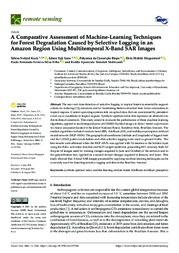A Comparative Assessment of Machine-Learning Techniques for Forest Degradation Caused by Selective Logging in an Amazon Region Using Multitemporal X-Band SAR Images.
A Comparative Assessment of Machine-Learning Techniques for Forest Degradation Caused by Selective Logging in an Amazon Region Using Multitemporal X-Band SAR Images.
Autoria: KUCK, T. N.; SANO, E. E.; BISPO, P. da C.; SHIGUEMORI, E. H.; SILVA FILHO, P. B. F.; MATRICARDI, E. A. T.
Resumo: Abstract: The near-real-time detection of selective logging in tropical forests is essential to support actions for reducing CO2 emissions and for monitoring timber extraction from forest concessions in tropical regions. Current operating systems rely on optical data that are constrained by persistent cloud-cover conditions in tropical regions. Synthetic aperture radar data represent an alternative to this technical constraint. This study aimed to evaluate the performance of three machine learning algorithms applied to multitemporal pairs of COSMO-SkyMed images to detect timber exploitation in a forest concession located in the Jamari National Forest, Rondônia State, Brazilian Amazon. The studied algorithms included random forest (RF), AdaBoost (AB), and multilayer perceptron artificial neural network (MLP-ANN). The geographical coordinates (latitude and longitude) of logged trees and the LiDAR point clouds before and after selective logging were used as ground truths. The best results were obtained when the MLP-ANN was applied with 50 neurons in the hidden layer, using the ReLu activation function and SGD weight optimizer, presenting 88% accuracy both for the pair of images used for training (images acquired in June and October) of the network and in the generalization test, applied on a second dataset (images acquired in January and June). This study showed that X-band SAR images processed by applying machine learning techniques can be accurately used for detecting selective logging activities in the Brazilian Amazon.
Ano de publicação: 2021
Tipo de publicação: Artigo de periódico
Unidade: Embrapa Cerrados
Palavras-chave: Desmatamento, Sensoriamento Remoto, Synthetic aperture radar
Observações
1 - Por padrão são exibidas publicações dos últimos 20 anos. Para encontrar publicações mais antigas, configure o filtro ano de publicação, colocando o ano a partir do qual você deseja encontrar publicações. O filtro está na coluna da esquerda na busca acima.
2 - Para ler algumas publicações da Embrapa (apenas as que estão em formato ePub), é necessário ter, no celular ou computador, um desses softwares gratuitos. Sistemas Android: Google Play Livros; IOS: iBooks; Windows e Linux: software Calibre.
Acesse outras publicações
Acesse a Base de Dados da Pesquisa Agropecuária (BDPA) para consultar o acervo completo das bibliotecas da Embrapa.

